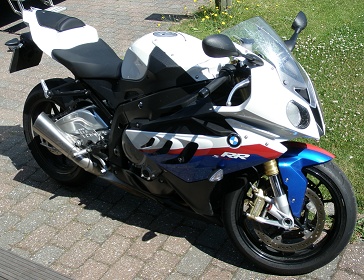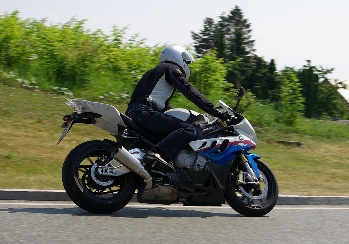Superbikes On the Road 25. juli 2010
BMW S1000RR versus Honda CBR1000RR Fireblade
Introduction
My friend Teis and I road-tested the BMW S1000RR 2009 which entered the
superbike scene in 2009 and we are in this article comparing it with my
Honda CBR1000RR Fireblade 2008. Teis has a Suzuki GSX1300 Hayabusa
2007 which unfortunately was in for service in the days we had the BMW, so
there are unfortunately no pictures of the Hayabusa from these days.
 As the title says we are not testing the S1000RR on race track because we are
in no way racing experts. But we both drive several thousand kilometers every
year on normal roads on our own superbikes, and it is in this context we will be
comparing the bikes.
As the title says we are not testing the S1000RR on race track because we are
in no way racing experts. But we both drive several thousand kilometers every
year on normal roads on our own superbikes, and it is in this context we will be
comparing the bikes.
I picked the BMW S1000RR up in the western part of Denmark on a very sunny and
warm Friday afternoon.
It was a 2009 demonstration model which had been in the ‘kind’ hands of professional
bike jurnalists during the first half of 2010, so it had been broken in with 7161 km on
the meter, and with little or probably no service att all since brand new. It looked
awesome in the sunshine!
The rear tire had no chicken stripes, so the bike had clearly been driven by drivers
knowing how to get it down. I must admit that my own Honda CBR1000RR Fireblade 2008
model at 19.000 km still has 2 mm chicken stripes on the rear tire, and had it not been
for a resent track day at Ring Knutstorp in Sweeden with
Mestersvinger (highly
recommendable!) there would still have been 15 mm each side  .
.
The Blade has behaved flawlessly since new and only received oil service at 12.000
km plus one front tire replacement at 17.500. Hence I guess it is justified to compare
the two bikes despite the difference in age and mileage.
The Sound
With some exitement I turned the ignition key and hit the starter switch. It turned
over with a remarkably good quality sound from the starter motor and sprang to life in
about one second. Here came the first big surprise. I’m used to the very very silent
Blade which ‘sounds like a little cat’ when idle, but the BMW immediately growled at me
‘like a lion’, even with no gas on. The sound pattern was excellent, a powerfull but
restrained engine, just waiting for gass input.
My first guess was that BMW did not have an exhaust gas bypass valve like the Blade
has, but later I was proved wrong by BMW’s technical specialist Lars (from
Jens Winther Automobiler),
who pointed to the front end of the silencer where the BMW indeed has such a valve.
It just doesn’t seem to affect the sound pattern much, like it does on the Blade.
Drivers and Passengers Position and Comfort
 I already new that the drivers position on the BMW was almost identical to that on
the Blade, because I tried sitting on the BMW at an exhibition this spring.
I already new that the drivers position on the BMW was almost identical to that on
the Blade, because I tried sitting on the BMW at an exhibition this spring.
Within seconds I felt ‘at home’ in the seat. There was almost no difference to feel.
After the first 2 km I tried closing my eyes (not for too long though!), and apart
from the much higher sound level from the BMW, I could almost forget not being on the
Blade
You really sit in a very relaxed position on both these bikes. There is almost no
load on your wrists, so both bikes are good for many hours of driving without getting
tired.
Teis's Hayabusa is even better in this aspect. At low speeds there is a high load
on your wrists, while you seem to be flying completely weightless on the stearing
handle at any speed above 130 km/h! – and I litterally mean weightless. There is no
force required at all on your wrists, except what is needed to keep the gas on. If you
go faster than 130 km/h on the Hayabusa, you just bend your albows a little to find
balance between up and down forces – that is amazing!
The gas response was smooth like on the Blade, and at the same time very responsive.
You get excactly what you ask for, no more no less. And for normal driving in the trafic
you of cause don´t need to ask for much. Twisting the gas a few degrees is usually
enough, and that is one of the great benefits of these superbikes. Lots of power and
low weight. On my starter bike, a Honda CB500 from 2002, I had to twist the gass more
than half a turn when making a take-over.
Getting on the motorway I could get an impression of the fairings efficiency.
There was almost no turbulence to feel anywhere and at any speed. Just as on the Blade
there was almost no wind on the hands, and that is an important feature in Denmark,
especially if you want to be on the road early or late in the season where temperatures
are typically close to 5 degree C. I have heated grips on my Honda CBF1000A where they
are indeed needed, but on these two superbikes the lee for the hands is superb so heated
grips are not really needed.
I felt slightly more wind on my arms on the BMW than I’m used to with the Fireblade.
Also vibrations in the hands were marginally higher, but on both bikes the vibration
level is very low indeed.
Soon after, I noticed another difference from the Blade. The BMW got quite hot
between my thighs and in my crotch. Much more than I’m used to on the Blade. As I
mentioned earlier it was indeed a sunny and unusual warm weekend. The following day
Teis noticed the same thing. A couple of times when we made stops, he used a hose with
cold running water to cool down the frame metal (it could have something to do whith him
driving in shorts only!).
Next Page
See also:
First Year
with my Fireblade
Front Page Of DIY Section
© Copyright 2010 FireBladerDk - 2011-01-13
 As the title says we are not testing the S1000RR on race track because we are
in no way racing experts. But we both drive several thousand kilometers every
year on normal roads on our own superbikes, and it is in this context we will be
comparing the bikes.
As the title says we are not testing the S1000RR on race track because we are
in no way racing experts. But we both drive several thousand kilometers every
year on normal roads on our own superbikes, and it is in this context we will be
comparing the bikes. .
.